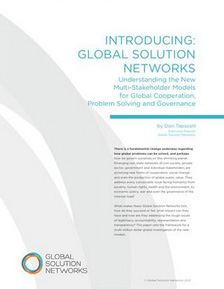Nobel prize-winning economist Ronald Coase has just celebrated his 100th birthday. Coase is a brilliant thinker and his insights were enormously influential on me and many of my colleagues. His 1991 Nobel was “for his discovery and clarification of the significance of transaction costs … for the institutional structure and functioning of the economy.”
The first time I heard Coase’s name was from my colleague Riel Miller, who was working for the OECD in 1994. He speculated that Coase and a paper he had written in the 1930s might be the key to understanding the Internet. We had a number of discussions about Coase’s work and I began to use his analytical framework in my own research and credit Coase’s insights in almost every speech I gave.
Following is an excerpt from my 1995 book, The Digital Economy:
Theme 4: Molecularization
• The new economy is a molecular economy. The old corporation is being disaggregated, replaced by dynamic molecules and clusters of individuals and entities which form the basis of economic activity. The organization does not necessarily disappear, but it is transformed. “Mass” becomes “molecular” in all aspects of economic and social life.
The principal economic unit of the industrial economy was the corporation. The command-and-control hierarchy found its roots in the church and military bureaucracies of the agricultural age but was extended to become the firm. The objective of every CEO and board was to grow the corporation’s size, revenue and profit.
The traditional hierarchy has been in deep trouble for years now because it was poorly equipped to respond to the new business needs. Conventional wisdom of the last decade has called for more responsive, flatter, team based structures. The most significant movement to create such horizontal, process-oriented structures is business process reengineering.
However, as Riel Miller, an economist working with the Alliance for Converging Technologies, put it: “The necessity of adding knowledge at every step in the value chain is beginning to call into question the familiar notion of the firm as an organizational unit. The Net may be, at one and the same time, the source of both the demise and salvation of the firm as we have known it.”[i][i]
Over fifty years ago a famous economist, [Ronald] Coase, asked why firms exist. Why are there groups of people working together under one organizational framework? He wondered why there is no market within the firm. Why is it unprofitable to have each worker, each step in the production process, become an independent buyer and seller? Why doesn’t the draftsperson auction their services to the engineer? Why is it that the engineer does not sell designs to the highest bidder?
One of the main answers to these questions has to do with the cost of information. Producing a loaf of bread, assembling a car or running a hospital emergency ward involves a number of steps where cooperation and common purpose are essential for a useful product. An emergency room where each doctor bids for nursing services in an attempt to get the lowest price, while at the same time determining if the nurse is actually capable of assisting with the operation, might provide a fully functioning market but not a particularly useful product for a dead patient. Similarly, holding an auction before the axle assembler would pass along product to the chassis assembler might slow down the line. It would be even less efficient if the information on engineering viability and compatibility needed to be purchased on the shop-floor marketplace at every step.
What makes a pure market impractical is the time and cost of acquiring the information needed to undertake complex production processes. What is being sold? What is the quality of the labor? What is the quality of the raw material or intermediate input? What is the price for the final product? How will it be sold? By whom? With what kind of information or marketing? Who will finance the production process and how much will financing cost? The ensemble of functions within a firm consist not only of a series of discrete products but also the infrastructure of collaboration.
A clear framework and strict regimentation worked on many battlefields and marketplaces of the past. The role of the overarching infrastructure of the firm or army was clear and indivisible. But today, as Miller puts it: “The Net does not change the rules, but it changes what is possible. It opens up new horizons for what is economically and practically feasible. The costs of information and coordination are dropping. More than ever we are in a position to create wealth by adding knowledge to each product at each step.”
The industrial hierarchy and economy are giving away to molecular organizations and economic structures. The word molecularization is awkward, but helpful. In physics, a molecule is one of the basic elements of matter. It is the smallest particle into which a substance can be divided and still have the chemical identity of the original substance. Molecules can be held together by electrical forces. In solids, attracting and repelling forces are balanced, holding the molecules in place. The molecules do not have enough energy to move to another part of the solid. In liquids, the molecules move about easily although they still have attractive forces between each other. Certain organic compounds called liquid crystals have properties of both liquids and solids – molecules form clusters which can move about and change rapidly, yet they retain a degree of structure. As conditions change (temperature), the state of the molecules changes as well.
The analogy is helpful in understanding the new economy. The new enterprise has a molecular structure. It is based on the individual. The knowledge worker (human molecule) functions as a business unit of one.[ii][ii] Motivated, self-learning, entrepreneurial workers empowered by and collaborating through new tools apply their knowledge and creativity to create value. Conditions may warrant a solid structure – tightly binding molecules together. More likely, conditions will require more dynamic relationships between molecules – causing them to cluster in teams like liquid crystals, or even to move more freely as in liquids. The capacity for new relationships is profoundly increased through the new infostructure. There is still a role for the organization to provide a base structure for such molecular activity, but it is a far cry from the old hierarchy.
When such molecular activity is extended to the economy as a whole, we can see very different kinds of relationships which make discussion of the virtual corporation seem trite. For example, the mass media will become the molecular media, where readers, listeners, and viewers become customers able to access and interact with millions of “channels.” They do so when they choose, rather than according to the schedule of a broadcaster. Mass production becomes molecular production with production runs of one – rather than one million – pairs of jeans. Even products become composed of molecules which are link together through standard interfaces. The software industry is becoming a parts industry where companies build and market parts which work with others. Just as a modern wide-body jet is referred to in the industry as a “complex assembly of parts flying in close formation” because most of these parts are not manufactured by Boeing or Lockheed or McDonnell Douglas, but by their suppliers, mass marketing becomes molecular marketing as marketers identify specific customer groups or individuals to receive sales information.
[i][i] Thanks to Riel Miller for his insights on this section.
[ii][ii] The first to introduce the notion of a business unit of one were Stan David and Bill Davidson in “2020 Vision: Transform your Business Today to Succeed in Tomorrow’s Economy.” Simon and Schuster, New York, 1991. Subsequently Tom Peters has taken up the slogan in his “Tom Peters Seminars.”





